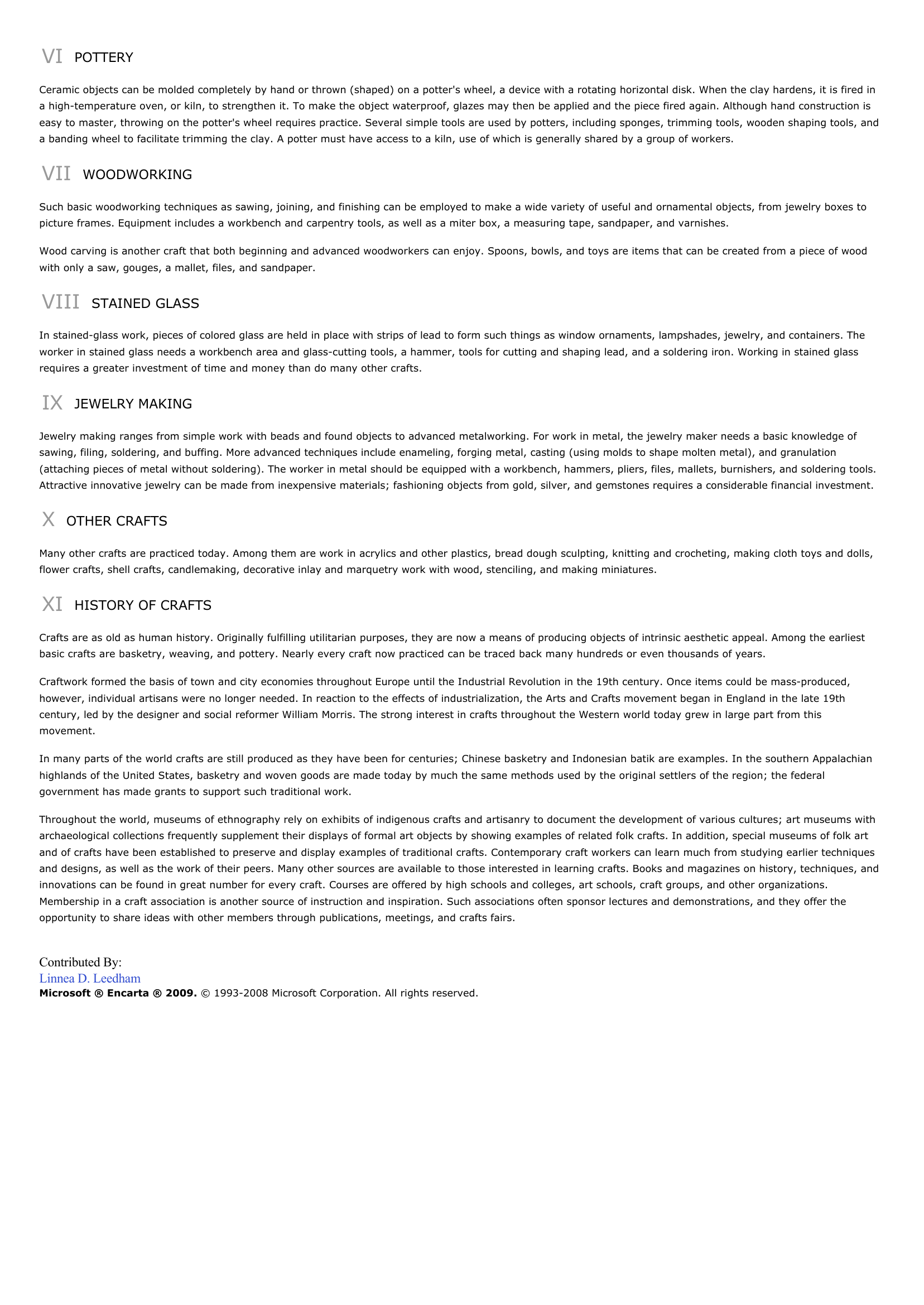Crafts.
Publié le 14/05/2013

Extrait du document
«
VI POTTERY
Ceramic objects can be molded completely by hand or thrown (shaped) on a potter's wheel, a device with a rotating horizontal disk.
When the clay hardens, it is fired ina high-temperature oven, or kiln, to strengthen it.
To make the object waterproof, glazes may then be applied and the piece fired again.
Although hand construction iseasy to master, throwing on the potter's wheel requires practice.
Several simple tools are used by potters, including sponges, trimming tools, wooden shaping tools, anda banding wheel to facilitate trimming the clay.
A potter must have access to a kiln, use of which is generally shared by a group of workers.
VII WOODWORKING
Such basic woodworking techniques as sawing, joining, and finishing can be employed to make a wide variety of useful and ornamental objects, from jewelry boxes topicture frames.
Equipment includes a workbench and carpentry tools, as well as a miter box, a measuring tape, sandpaper, and varnishes.
Wood carving is another craft that both beginning and advanced woodworkers can enjoy.
Spoons, bowls, and toys are items that can be created from a piece of woodwith only a saw, gouges, a mallet, files, and sandpaper.
VIII STAINED GLASS
In stained-glass work, pieces of colored glass are held in place with strips of lead to form such things as window ornaments, lampshades, jewelry, and containers.
Theworker in stained glass needs a workbench area and glass-cutting tools, a hammer, tools for cutting and shaping lead, and a soldering iron.
Working in stained glassrequires a greater investment of time and money than do many other crafts.
IX JEWELRY MAKING
Jewelry making ranges from simple work with beads and found objects to advanced metalworking.
For work in metal, the jewelry maker needs a basic knowledge ofsawing, filing, soldering, and buffing.
More advanced techniques include enameling, forging metal, casting (using molds to shape molten metal), and granulation(attaching pieces of metal without soldering).
The worker in metal should be equipped with a workbench, hammers, pliers, files, mallets, burnishers, and soldering tools.Attractive innovative jewelry can be made from inexpensive materials; fashioning objects from gold, silver, and gemstones requires a considerable financial investment.
X OTHER CRAFTS
Many other crafts are practiced today.
Among them are work in acrylics and other plastics, bread dough sculpting, knitting and crocheting, making cloth toys and dolls,flower crafts, shell crafts, candlemaking, decorative inlay and marquetry work with wood, stenciling, and making miniatures.
XI HISTORY OF CRAFTS
Crafts are as old as human history.
Originally fulfilling utilitarian purposes, they are now a means of producing objects of intrinsic aesthetic appeal.
Among the earliestbasic crafts are basketry, weaving, and pottery.
Nearly every craft now practiced can be traced back many hundreds or even thousands of years.
Craftwork formed the basis of town and city economies throughout Europe until the Industrial Revolution in the 19th century.
Once items could be mass-produced,however, individual artisans were no longer needed.
In reaction to the effects of industrialization, the Arts and Crafts movement began in England in the late 19thcentury, led by the designer and social reformer William Morris.
The strong interest in crafts throughout the Western world today grew in large part from thismovement.
In many parts of the world crafts are still produced as they have been for centuries; Chinese basketry and Indonesian batik are examples.
In the southern Appalachianhighlands of the United States, basketry and woven goods are made today by much the same methods used by the original settlers of the region; the federalgovernment has made grants to support such traditional work.
Throughout the world, museums of ethnography rely on exhibits of indigenous crafts and artisanry to document the development of various cultures; art museums witharchaeological collections frequently supplement their displays of formal art objects by showing examples of related folk crafts.
In addition, special museums of folk artand of crafts have been established to preserve and display examples of traditional crafts.
Contemporary craft workers can learn much from studying earlier techniquesand designs, as well as the work of their peers.
Many other sources are available to those interested in learning crafts.
Books and magazines on history, techniques, andinnovations can be found in great number for every craft.
Courses are offered by high schools and colleges, art schools, craft groups, and other organizations.Membership in a craft association is another source of instruction and inspiration.
Such associations often sponsor lectures and demonstrations, and they offer theopportunity to share ideas with other members through publications, meetings, and crafts fairs.
Contributed By:Linnea D.
LeedhamMicrosoft ® Encarta ® 2009. © 1993-2008 Microsoft Corporation.
All rights reserved..
»
↓↓↓ APERÇU DU DOCUMENT ↓↓↓
Liens utiles
- Arts and Crafts - encyclopédie.
- Arts and Crafts - arts décoratifs.
- Arts and Crafts Mouvement anglais créé en 1888, principalement par W.












